Discover the Inspiring Musical Magic and Distinctive Touch of Guitar Legend Joe Walsh
Find the magic that can be created by focusing on not only what notes you play but also how you play them
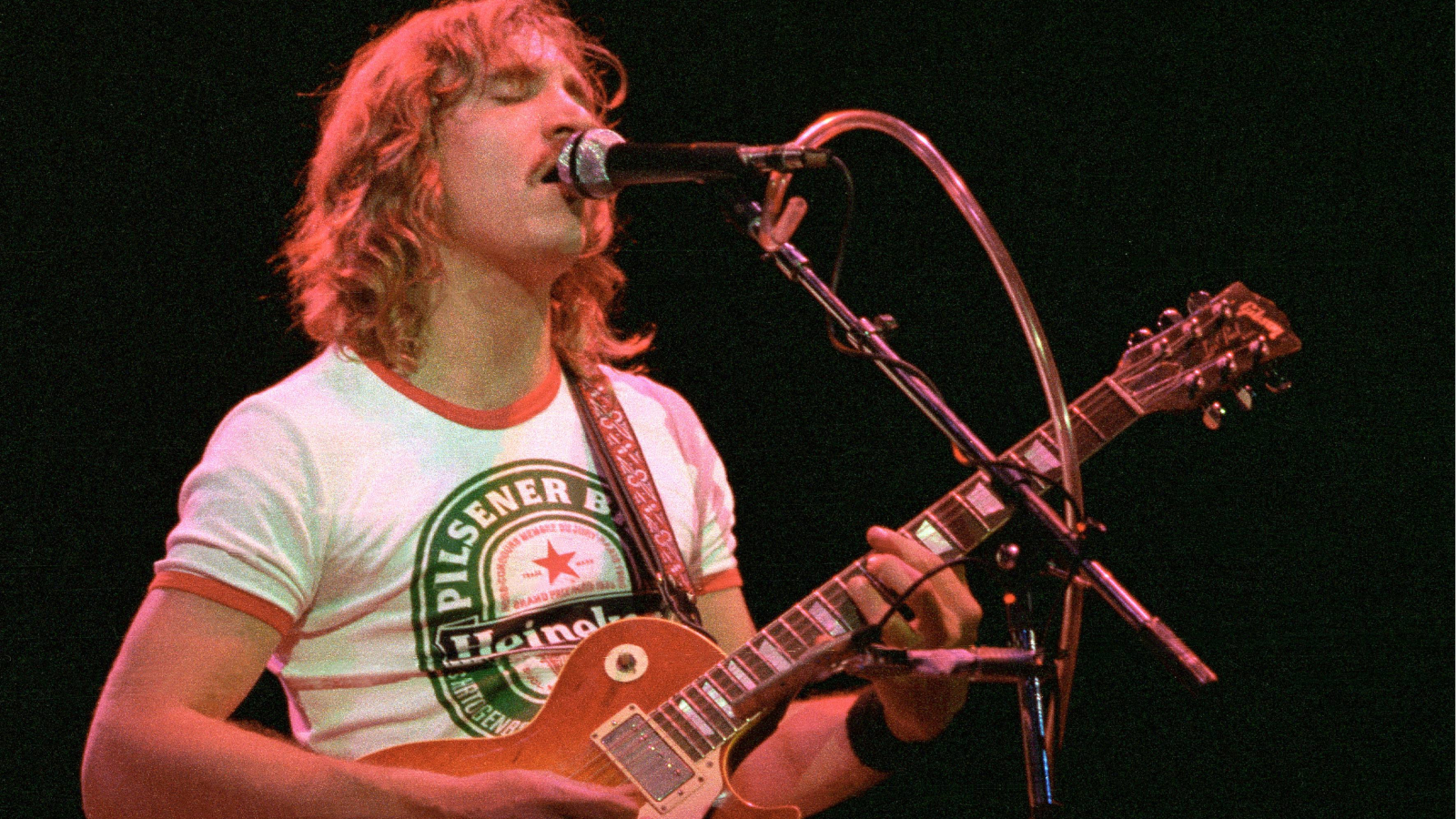
I have worked as a professional music transcriber for most of my life, transferring music (especially guitar music) from the air to the page. Even before that, as a kid, I would always be doing what I then called “figuring stuff out,” trying to decipher the magic I heard in my favorite musicians’ playing. One day, I was struck by Louis Armstrong’s trumpet solo on one of my dad’s old recordings, and I knew right away I had to play it, in particular, one especially cool-sounding phrase. Once I figured it out, I quickly realized it was something I already knew how to play. I recalled that this had happened a couple of times before, and I had simply shrugged it off.
But this time, it made me stop and think. As it turned out, I had stumbled onto one of the most important lessons I would learn about music: What made me want to learn that solo wasn’t as much the notes as how Armstrong played them. In comedy, this is known as delivery. In music, we call it style, or phrasing – that elusive element imbuing notes with a special personal quality that makes you want to listen again and again, even though you already know the “punchline.”
Joe Walsh is a master of phrasing, and it’s no coincidence he also has a legendary sense of humor. Throughout his time with James Gang, his solo career and, of course, his continuing run with the Eagles, Walsh has written or co-written many classic songs and created some of the most memorable and catchy guitar parts committed to tape. There’s even an internet meme floating around that says, “Even people who hate the Eagles are like, ‘but Joe Walsh is alright.’” Let’s explore what makes this celebrated guitarist’s playing so much fun to listen to, while we learn more concretely what phrasing is all about, and how focusing on it can help each of us find our unique guitar voice.
One of the most memorable licks Walsh has recorded is one of his earliest. It kicks off the classic tune “Funk #49” from James Gang’s 1970 album James Gang Rides Again. The lick is quirky and kind of funny – just like the man himself – and Ex. 1 brings this curious phrase to mind.
At first, it might seem a bit tricky: Sound the first note normally, with your pick. Then, while continuing to hold the bend, sound the deadened note that follows by lightly resting your pick-hand middle finger on the underside of the G string as you attack it with your pick.
The subsequent note is then plucked with that same middle finger, and the pattern repeats. Using a combination of both pick and fingers in this way or simultaneously is known as hybrid picking. If you try playing the phrase without deadening the string, you’ll see how quickly the magic vanishes.
Also, notice how some of the pitches sounded during the long release (the three-quarter- and one-quarter-step bends) can’t be found conventionally on the fretboard, but, as guitarists, we can exploit our ability to bend strings to sound the pitches “in the cracks” between the fretted notes.
All the latest guitar news, interviews, lessons, reviews, deals and more, direct to your inbox!
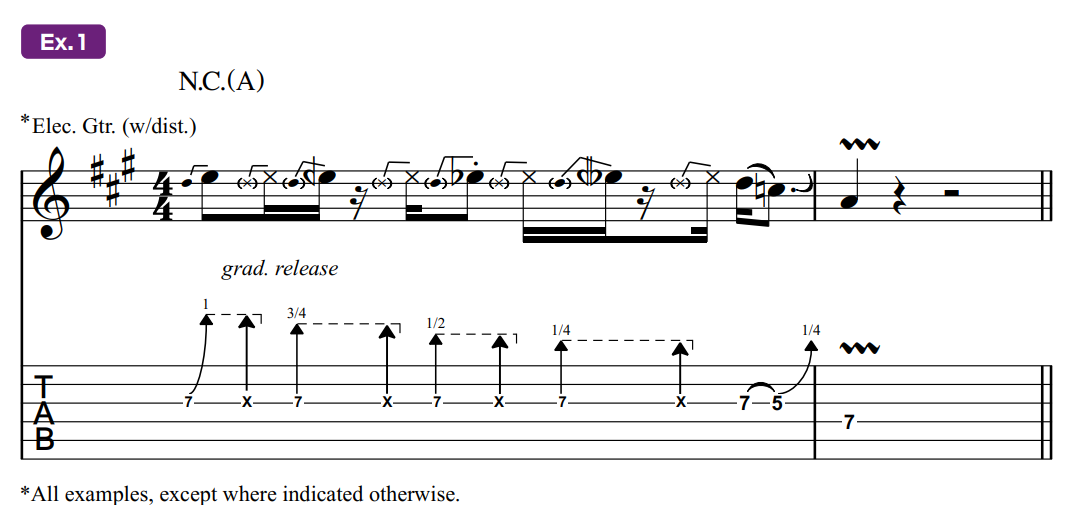
Ex. 2 offers another lick inspired by Walsh’s playing in this song. Using a backward rake, a ghost bend – a silently bent note struck to sound only its release – and a droning open string, Walsh again conveys his colorful personality with just a few notes.
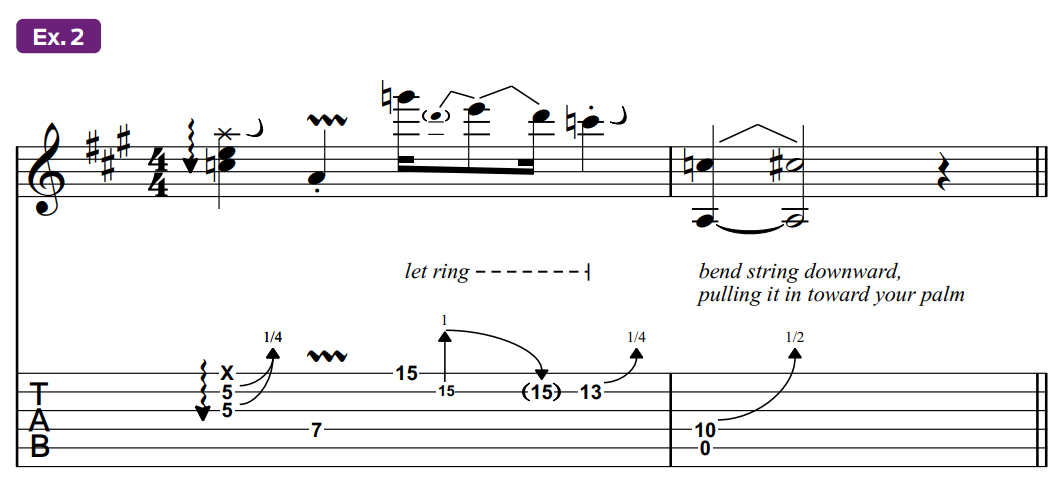
A hallmark of Walsh’s style is his sly use of decorative nuances, such as bends, finger slides, vibrato and more. Nuances are a key part of phrasing, and Joe uses them in all sorts of nifty ways.
In 1971, the guitarist left James Gang and formed the band Barnstorm with drummer Joe Vitale. That outfit’s second and final release, The Smoker You Drink The Player You Get, was released under Walsh’s name and included the juggernaut FM radio staple “Rocky Mountain Way.” In it, the guitarist adds some of his characteristically swampy electric slide playing, as well as some of his trademark lead work, aided by the use of a talk box.
The song also showcases Walsh’s talent for writing super-catchy and memorable riffs, which often reside in the guitar’s lower register. Ex. 3 is inspired by the riff featured in the song’s breakdown section and is similarly based on the E minor pentatonic scale (E, G, A, B, D).
Notice how almost all of the notes have some sort of nuance attached, whether it be a finger slide, vibrato or a dot on top indicating it’s to be played staccato, or short. Here, the deadened notes are played softly, adding some rhythmic “bounce,” and are sounded by lightly resting your 3rd finger on the 6th string’s 7th fret as you pick.
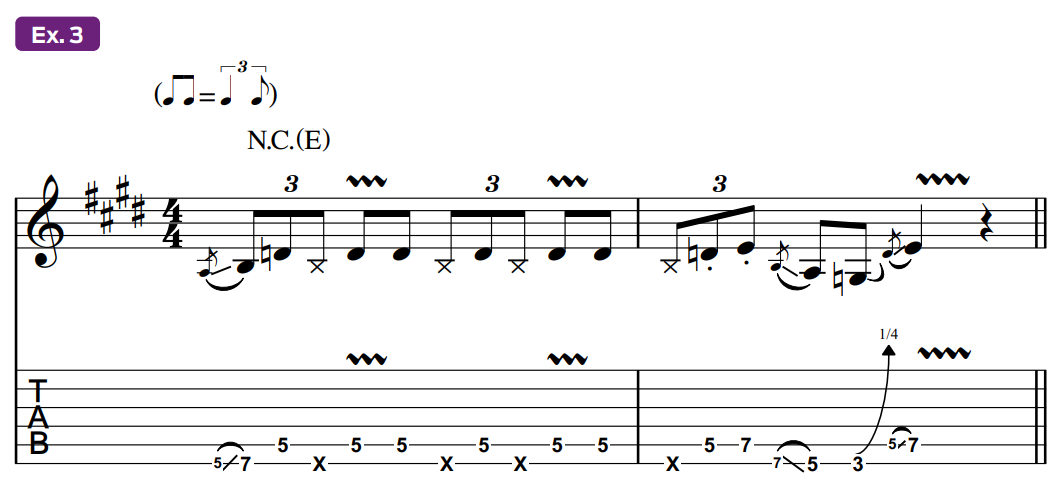
The guitarist was shown how to play slide by none other than the great Duane Allman, and Ex. 4 is inspired by Walsh’s take-no-prisoners approach to slide.
While his guitar is tuned to open E, (low to high, E, B, E, G#, B, E), you really only need to tune your G string up to G# to be able to play this phrase, as the notes all fall on the top three strings.
Notice again how almost every note has a slide or vibrato indicated. Covered further in my “What Should I Practice?” lessons in the September and October 2022 issues of Guitar Player, nuances like the ones we’re exploring here are often thought of as the “little things,” but they have enormous potential to add personality and style to your playing.
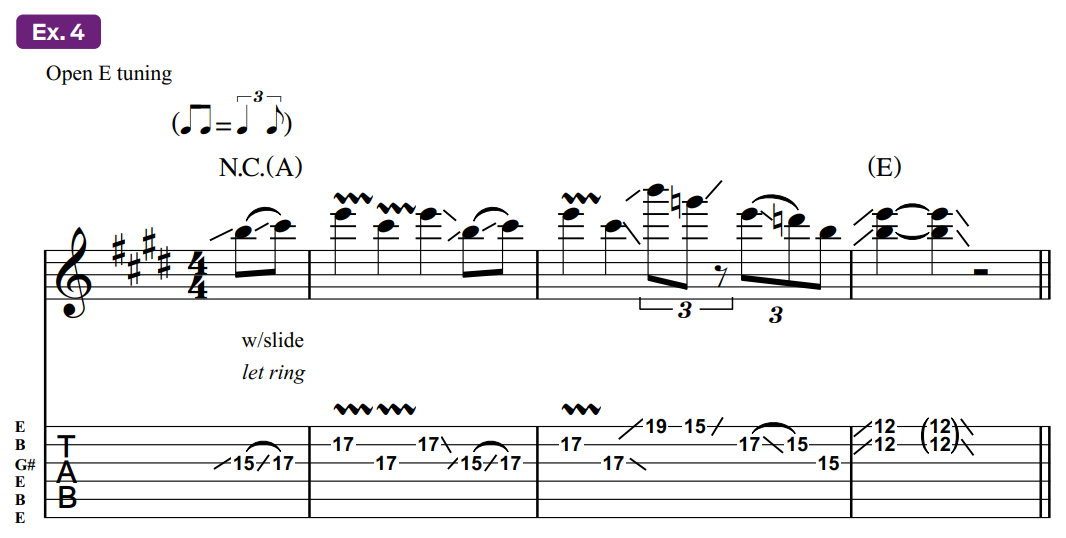
In 1975, Walsh made his Eagles debut, appearing on the band’s fifth studio album, Hotel California. It includes the classic title track that features, during its outro, the epic trading-licks solo that Walsh shares with fellow lead guitarist Don Felder.
A couple of songs later, the Eagles hit again with, this time with the Walsh co-write “Life in the Fast Lane,” which emerged from a low-register pentatonic riff the guitarist had been using as a warm-up. Throughout the song, he also crafted some tasty melodic fills, which inform Ex. 5.
Here, bends are used in more of a country style, similar to what a pedal-steel guitarist might play. Be sure to see the suggested fingerings included in this example, and notice in bar 2 how the gradual nature of the bend and release reveal the satisfying tension that’s found in between the guitar’s fretted pitches.

Ex. 6 brings to mind Walsh’s playing in the song’s outro solo, where he again uses ghost bends in his own inimitable way.
The rhythm of our example’s first bend release is notated strictly, but to summon the full desired effect, make the release as gradual as possible, its lowest point reached just a hair before you strike the following note.
As with pitch, what’s found in the space between concrete rhythms is often where the musical magic lies. Relying on your ears more than your eyes will go a long way toward getting these examples to sound just right.
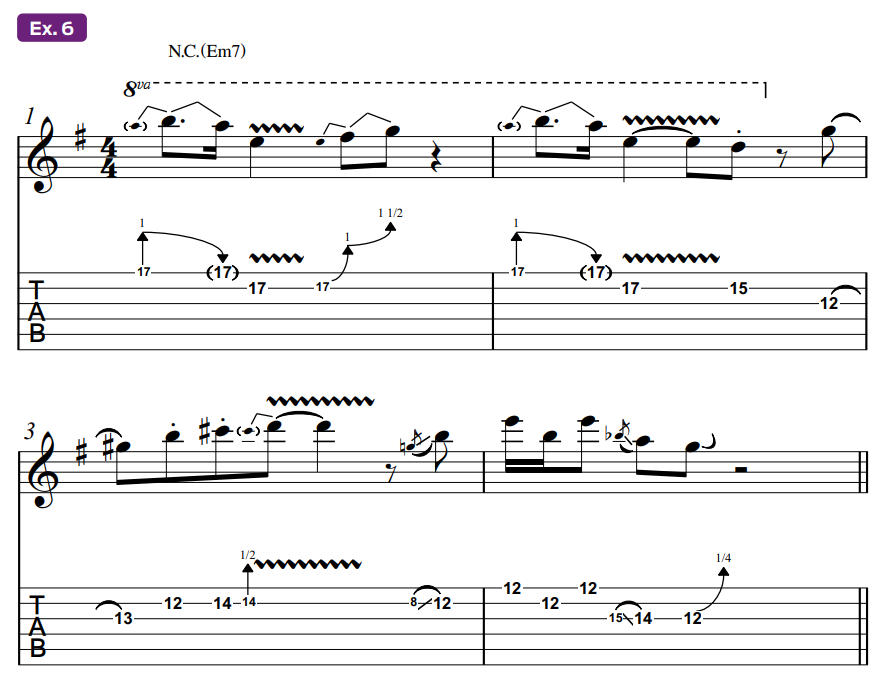
Walsh’s lead playing is often blues-based, but he also has a penchant for inserting catchy melodic phrases that aren’t born from this style.
An example can be heard in the outro of “In My Car,” from his 1987 solo album, Got Any Gum?. Joe both literally and figuratively reaches outside the (pentatonic) box to create a memorable hook that’s repeated over the chord changes. Ex. 7 is inspired by this hooky phrase.
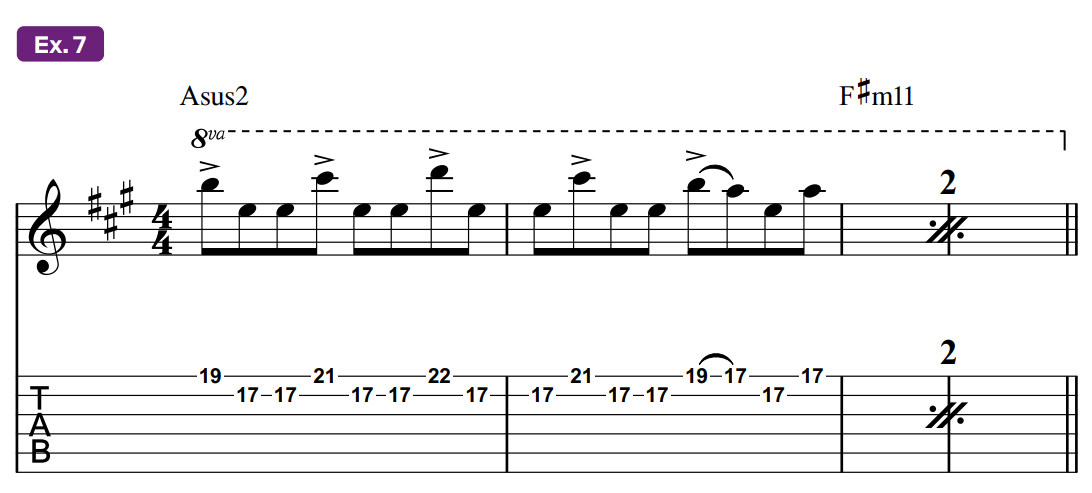
Walsh also shows his contemplative side in his songwriting, as heard in a passage from the title track to his 1985 solo album, The Confessor.
In the intro, the guitarist uses double drop-D tuning (low to high, D, A, D, G, B, D) to add a lovely part, which mixes open strings and fretted notes on a clean electric guitar.
Ex. 8 is reminiscent of his playing here.
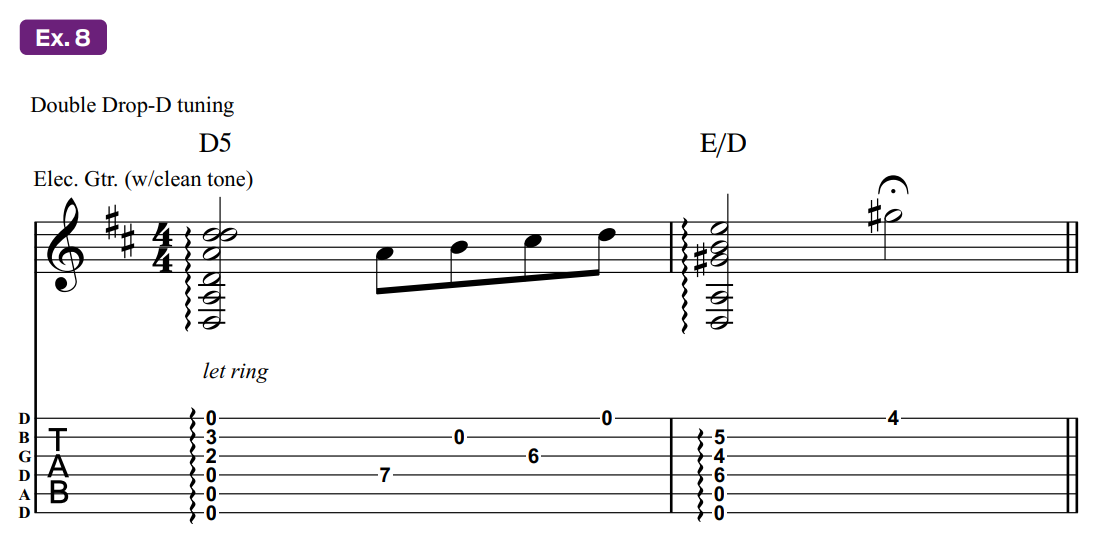
A pair of Walsh’s classic rhythm guitar parts can be found in “Life’s Been Good,” from his 1978 solo album, But Seriously, Folks…
Inspired by the song’s intro, Ex. 9 is a hummable riff created by a mix of single notes and chords. Notice how the muted strums in the final bar add some rhythmic spice.
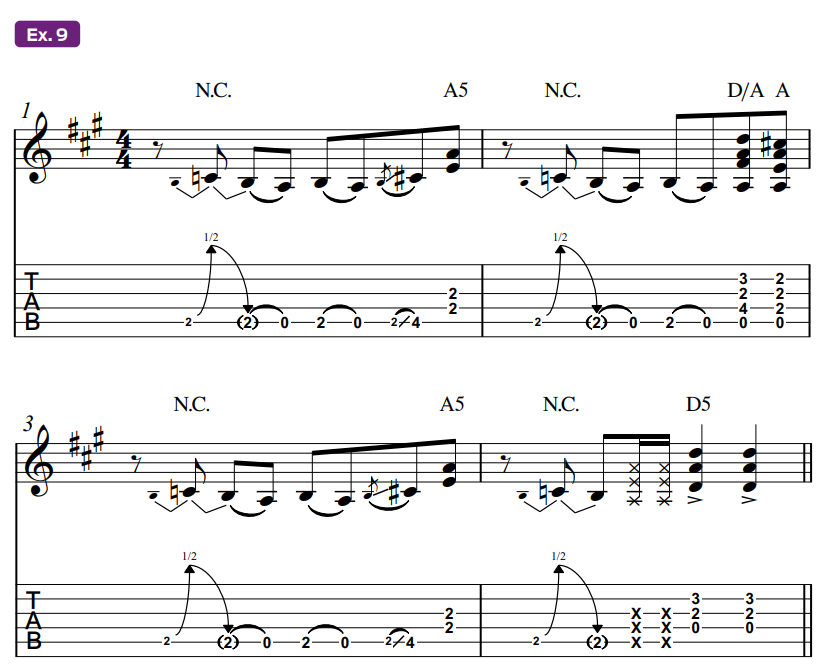
Ex. 10 is influenced by the acoustic guitar interlude in this track and is composed of a series of triads that create another irresistible melodic line.
In this way, Walsh’s songs almost always have numerous instrumental hooks, courtesy of his catchy guitar riffs.
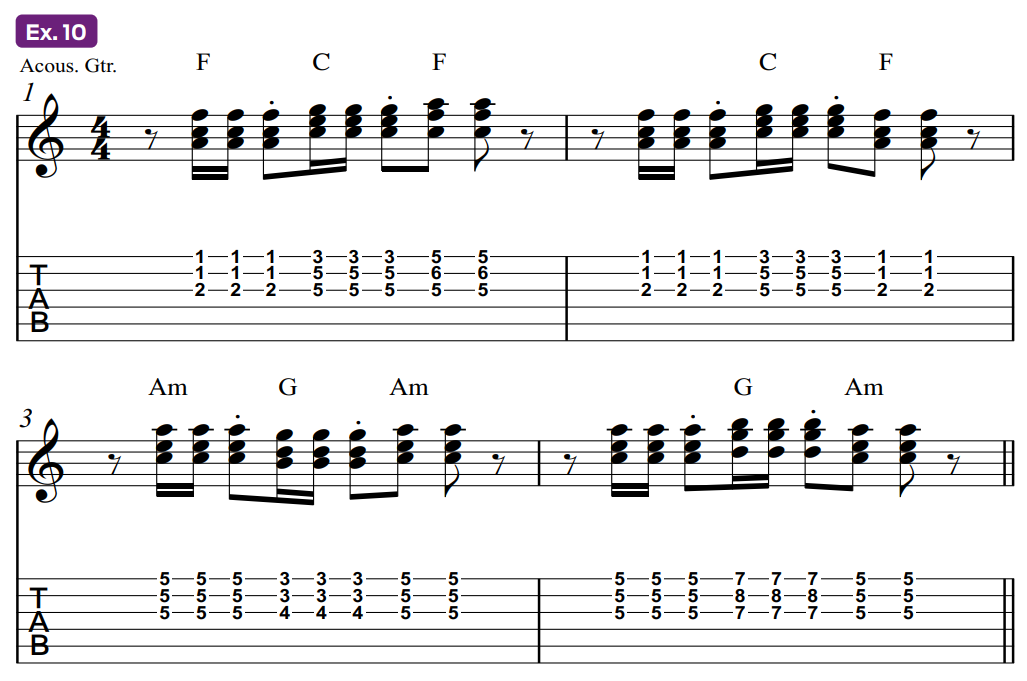
Joe will sometimes take a simple rhythm guitar idea but play it in a way that’s rhythmically skewed, often using syncopation – accentuating the weak part of a beat, also known as the “and” or “upbeat.”
Ex. 11 is reminiscent of “I Can Play That Rock & Roll,” from his humorously titled 1983 solo album, You Bought It – You Name It.
Note how the use of space, offset by chordal stabs on the upbeats, keeps us on our toes. Listen to the riff a few times, until you’re able to sing it. It will definitely help make for a quicker transition to your guitar.

Let’s close out this lesson with a look at Walsh’s guitar work in “Turn to Stone,” from his first official solo record, So What, released in 1974, one year before he joined the Eagles.
Ex. 12 is not unlike one of his solos, a plaintive cry that acts as a foil to the soothing Crosby, Stills & Nash-like vocal harmonies that precede it. As before, let the releases fall away without going for any specific rhythm. They should be free and easy, and, like Walsh, you should have some fun, too.
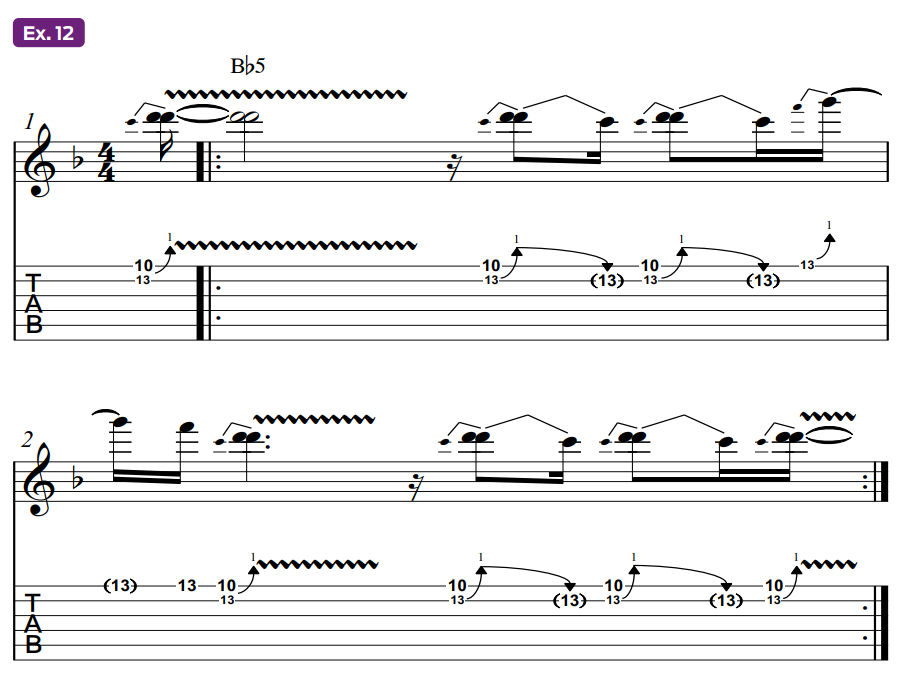
With his guitar, Joe Walsh conveys to the world his offbeat personality and wry sense of humor, with surprising directness. He accomplishes this by, among other things, finding the magic that can be created by focusing on not only what notes you play but also how you play them.
This is one of the vast musical spaces where one’s own unique voice as a guitarist can be discovered and claimed.
Jeff Jacobson is a guitarist, songwriter and veteran music transcriber, with hundreds of published credits. For information on virtual guitar and songwriting lessons or custom transcriptions, reach out to Jeff on Twitter @jeffjacobsonmusic or visit jeffjacobson.net.

